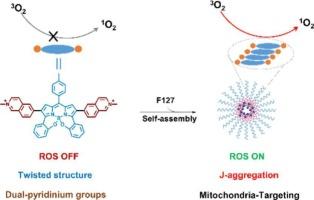具有装配增强ROS生成的j聚集BODIPY衍生物的超分子工程用于线粒体癌症治疗
IF 4.7
2区 医学
Q1 BIOCHEMISTRY & MOLECULAR BIOLOGY
引用次数: 0
摘要
我们通过双吡啶功能化扭曲BODIPY衍生物的超分子j聚集设计了一种靶向线粒体的纳米光敏剂(1a)。1a克服了聚集引起的猝灭(ACQ),同时实现了组装增强的ROS生成,证明单线态氧(o₂)的量子产率比单体形式提高了12.5倍。阳离子吡啶部分赋予双重功能:靶向线粒体和增强水分散。该设计协同解决了传统PDT的关键挑战:精确的时空ROS生成和聚集状态下有限的ROS产量,在小鼠肿瘤模型中实现了91%的肿瘤抑制。本文章由计算机程序翻译,如有差异,请以英文原文为准。

Supramolecular engineering of J-aggregated BODIPY derivatives with assembly-enhanced ROS generation for mitochondrial Cancer therapy
We engineered a mitochondria-targeting nanophotosensitizer (1a) through supramolecular J-aggregation of dual-pyridinium-functionalized twisted BODIPY derivatives. 1a overcomes aggregation-caused quenching (ACQ), while achieving assembly-enhanced ROS generation, demonstrating a 12.5× increase in singlet oxygen (1O₂) quantum yield versus its monomeric form. The cationic pyridinium moieties confer dual functionality: targeting mitochondria and enhancing aqueous dispersion. This design synergistically resolves key challenges in conventional PDT: precise spatiotemporal ROS generation and limited ROS yield in aggregated states, achieving 91 % tumor inhibition in murine tumor model.
求助全文
通过发布文献求助,成功后即可免费获取论文全文。
去求助
来源期刊

Bioorganic Chemistry
生物-生化与分子生物学
CiteScore
9.70
自引率
3.90%
发文量
679
审稿时长
31 days
期刊介绍:
Bioorganic Chemistry publishes research that addresses biological questions at the molecular level, using organic chemistry and principles of physical organic chemistry. The scope of the journal covers a range of topics at the organic chemistry-biology interface, including: enzyme catalysis, biotransformation and enzyme inhibition; nucleic acids chemistry; medicinal chemistry; natural product chemistry, natural product synthesis and natural product biosynthesis; antimicrobial agents; lipid and peptide chemistry; biophysical chemistry; biological probes; bio-orthogonal chemistry and biomimetic chemistry.
For manuscripts dealing with synthetic bioactive compounds, the Journal requires that the molecular target of the compounds described must be known, and must be demonstrated experimentally in the manuscript. For studies involving natural products, if the molecular target is unknown, some data beyond simple cell-based toxicity studies to provide insight into the mechanism of action is required. Studies supported by molecular docking are welcome, but must be supported by experimental data. The Journal does not consider manuscripts that are purely theoretical or computational in nature.
The Journal publishes regular articles, short communications and reviews. Reviews are normally invited by Editors or Editorial Board members. Authors of unsolicited reviews should first contact an Editor or Editorial Board member to determine whether the proposed article is within the scope of the Journal.
 求助内容:
求助内容: 应助结果提醒方式:
应助结果提醒方式:


